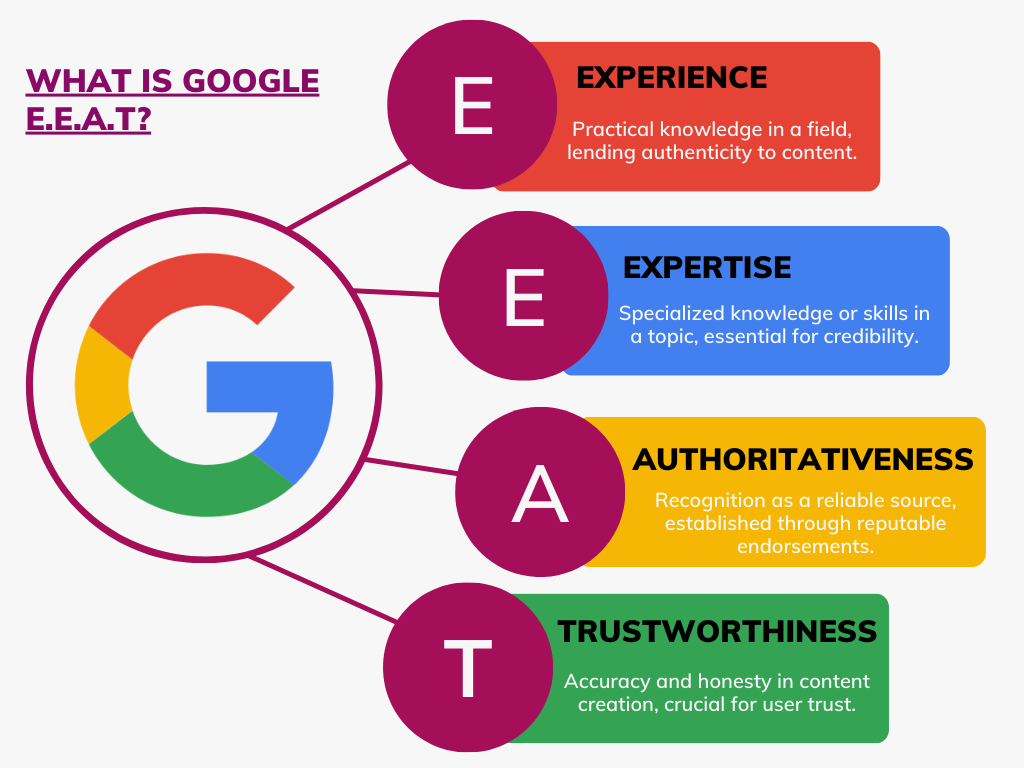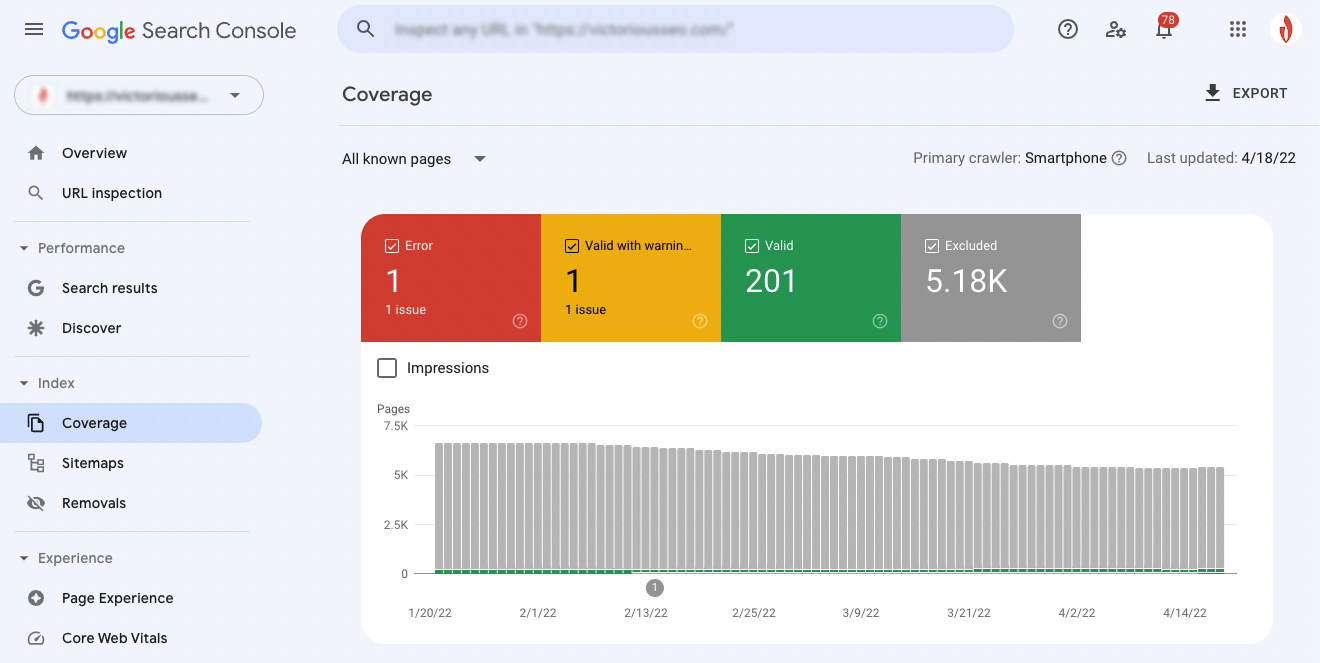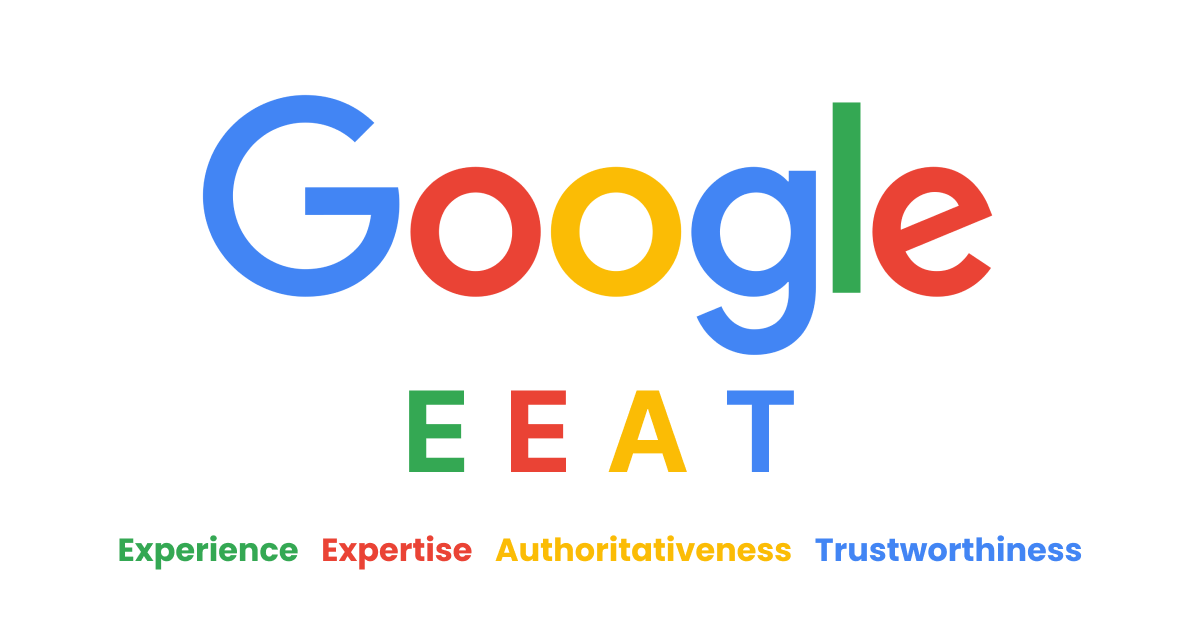If you’ve ever invested significant effort in creating content only to discover that Google refuses to index it, you’re not alone. In today’s competitive search ecosystem, Google has become increasingly selective about what content it includes in its index. At the heart of this decision-making process lies one of the most critical SEO concepts: E-E-A-T which stands for Experience, Expertise, Authoritativeness, and Trustworthiness. Google added 'Experience' to the original E-A-T framework, evolving its evaluation criteria to better assess content quality. According to Google's own guidelines, content is assessed based on these principles, and Google's standards play a key role in determining which pages are considered high quality. E-E-A-T is especially important for YMYL topics, subjects that can significantly impact users' health, safety, or financial wellbeing.

Although E-E-A-T is not a direct ranking factor, it heavily influences how Google evaluates your site’s overall quality. Evaluating your content using Google's criteria is essential to ensure it meets the necessary standards for trustworthiness and expertise. In many cases, the E-E-A-T signals of a page can determine whether it gets indexed at all. Pages rank is determined by a combination of quality factors reviewed by both Google's algorithms and human raters, rather than a single ranking metric. When content falls short of these standards, Google may crawl the page but choose not to index it, leaving it in the so-called “discovered but not indexed” state.
This article will explore how E-E-A-T connects to indexing, how to assess your content quality effectively, and how tools like Cromojo, a smart indexing assistant, can help ensure your valuable content doesn’t remain invisible in Google Search results.
The Connection Between E-E-A-T and Indexing
Indexing is the crucial process that allows your content to appear in search engines like Google. Indexing also enables efficient data retrieval for both users and search engines, making it easier and faster to access relevant information for comparison, analysis, and decision-making. When you publish a new web page, Google’s crawlers may find it, but inclusion in the index is not automatic. Google evaluates whether to index a page based on a combination of technical accessibility and content quality signals.
According to Google’s official documentation, the system prioritizes “helpful, reliable, people-first content.” In other words, if your content does not demonstrate strong E-E-A-T, it is unlikely to be indexed quickly or at all. This means that the quality content you create must reflect real-world experience and expertise to meet Google’s expectations.

How E-E-A-T Influences Indexing
Google’s indexing systems assess whether your page is worth storing in its massive database, the index. It’s not enough for a page to simply exist; it must provide unique, credible, and trustworthy value to users.
The components of E-E-A-T play a critical role in this evaluation:
- Experience and Expertise show Google that your content is created by authors who truly understand the subject matter and have real-world experience.
- Authoritativeness signals that your website and its authors are recognized and trusted within your industry or niche.
- Trustworthiness ensures that the content is accurate, transparent, and reliable. Topics related to financial stability are considered YMYL content (Your Money or Your Life), which means they require especially high levels of E-E-A-T to ensure users receive reliable and safe information.
When these signals are weak or missing, your site risks getting stuck in “indexing limbo,” where Google’s algorithm decides the content isn’t valuable enough to include in its index, resulting in slow or failed indexing.

Avoiding Index Bloat
Another important factor influencing Google’s indexing decision is “index bloat.” This occurs when a website contains too many low-value, thin, or redundant pages. According to Ahrefs, index bloat can dilute your domain’s perceived quality, waste crawl resources, and reduce your ability to get new, high-quality pages indexed.
To maintain strong search visibility and improve your site’s reputation with search engines, it’s essential to regularly remove or consolidate thin, duplicate, or outdated pages. Focusing on high-quality content that complies with E-E-A-T principles keeps your site lean, crawl-efficient, and authoritative in the eyes of Google.

The Difference Between E-E-A-T and E-A-T
Google’s approach to evaluating web content has evolved over time, and understanding the distinction between E-E-A-T and E-A-T is essential for anyone focused on search engine optimization. Originally, Google used the concept of E-A-T—Expertise, Authoritativeness, and Trustworthiness—to assess content quality and determine which pages deserved higher search visibility. These three pillars helped search engines evaluate whether a website’s content was credible, reliable, and created by knowledgeable sources.
In 2022, Google introduced an important update by adding “Experience” to the mix, transforming E-A-T into E-E-A-T. This new dimension emphasizes the value of real-world experience in content creation. Now, when Google evaluates a web page, it looks not only for expertise and authority but also for evidence that the content creator has first-hand experience with the subject matter. For example, a review written by someone who has actually used a product carries more weight than one written by someone with only theoretical knowledge.
For SEO professionals, this shift means that demonstrating real-world experience can significantly impact how search engines evaluate and rank your content. High quality content is no longer just about citing facts or credentials, it’s about showing that the author has genuinely engaged with the topic. By understanding and applying the principles of E-E-A-T, you can create content that stands out in search results and meets Google’s ever-evolving standards for quality.

The Self-Assessment Checklist for Content Quality
Before you publish a page or request indexing, it’s wise to evaluate your content’s E-E-A-T signals with this practical checklist. For example, content that provides financial information should be especially rigorous in meeting E-E-A-T standards to ensure accuracy and trustworthiness.
1. Experience
- Does the author demonstrate first-hand experience with the topic?
- Are there personal examples, original data, or case studies included?
- Can readers clearly tell that the content was created by someone who has actually done what they’re discussing?
2. Expertise
- Does the author hold relevant credentials or recognized authority in the subject matter?
- Is the content factually accurate, comprehensive, and well-researched?
- Does it cite reliable sources such as Search Engine Journal or other trusted references?
3. Authoritativeness
- Is the website well-known or frequently referenced by other credible sites in the industry?
- Do authoritative websites link back to your content?
- Are author bios, company information, and contact pages clearly visible to establish credibility?
4. Trustworthiness
- Is the content transparent about its sources, ownership, and purpose?
- Is the information current, verified, and regularly updated?
- Does the site use HTTPS, have clear navigation, and avoid deceptive ads or intrusive pop-ups?
5. Index-Readiness
- Is the page internally linked from other relevant pages on your site? Internal links from other pages help establish the authority and relevance of your content in Google's eyes.
- Is the content unique, substantial, and free from duplication?
- Have you submitted the page via a sitemap or an indexing tool like Cromojo?
- Are low-value or temporary pages properly marked with “noindex” to avoid index bloat?
Running through this checklist before submission ensures you’re providing Google with exactly what it wants: quality content created by real people that adds genuine value to users.
The Importance of Helpful Content
At the heart of Google’s search engine optimization philosophy is the idea of helpful content. Google’s automated systems are designed to prioritize web pages that genuinely serve users, rather than those created solely to manipulate search rankings. Helpful content is content that provides accurate, reliable, and trustworthy information tailored to the needs of your audience.

To create helpful content, focus on a people-first approach. This means writing for users, not just for search engines. Ask yourself: Does this page answer real questions? Does it solve a problem or provide valuable insights? When your site becomes a go to source for relevant information, you naturally improve your search quality and search visibility.
Google’s algorithms reward sites that consistently deliver helpful content by ranking them higher in search results. This not only benefits users, who find what they’re looking for more easily, but also helps your site build a reputation for quality. By aligning your content strategy with Google’s emphasis on helpful content, you ensure that your site remains competitive and visible in an ever-changing search landscape.
Best Practices for Content Creation

Creating content that stands out in today’s search engine landscape requires more than just targeting keywords—it demands a commitment to quality, relevance, and user value. To maximize your search engine optimization (SEO) efforts and demonstrate strong E-E-A-T (Experience, Expertise, Authoritativeness, and Trustworthiness), follow these best practices:
- Focus on People-First Content: Always prioritize the needs and questions of your users. Content should be written to inform, educate, or solve real problems, not just to rank in search results. Ask yourself: “Would I find this page genuinely helpful if I were searching for this topic?”
- Deliver a Great Page Experience: Ensure your web pages load quickly, are mobile-friendly, and offer intuitive navigation. A seamless user experience signals to search engines that your site values its visitors.
- Be Transparent and Accurate: Clearly identify content authors, cite reputable sources, and provide up-to-date information. Transparency builds trust and reinforces your site as a go-to source for reliable information.
- Demonstrate Relevance and Authority: Use original research, case studies, or expert commentary to showcase your expertise. The more your content draws on real-world experience and authoritative knowledge, the stronger your E-E-A-T signals. Incorporating insights from forum discussions can further strengthen user trust and credibility by providing firsthand user experiences and perspectives.
- Use AI-Generated Content Responsibly: While AI can help streamline the content creation process, it’s essential to review, edit, and enhance AI-generated content to ensure it meets Google’s quality guidelines. Avoid publishing unedited, generic AI content, as it can undermine your site’s credibility and search visibility.
- Stay Aligned with Google’s Guidelines: Regularly review Google’s recommendations for content quality and AI-generated content. Adhering to these standards helps ensure your pages are indexed and ranked appropriately. Remember, search quality raters play a key role in evaluating content quality according to E-E-A-T, providing feedback that helps refine Google's algorithms.
By consistently creating high quality content that embodies E-E-A-T, you not only improve your chances of ranking well in search results but also establish your brand as a trusted authority in your industry. While E-E-A-T is not a specific ranking factor, it strongly influences how content is evaluated and ranked by Google's systems. This approach drives more organic traffic, increases user engagement, and positions your website as a leader in your field.
Google’s Quality Rater Guidelines
Google’s Quality Rater Guidelines are a cornerstone in the evaluation of web content, providing a detailed framework for human quality raters to assess the overall quality of search results. These guidelines help quality raters determine whether a web page demonstrates strong E-E-A-T—Experience, Expertise, Authoritativeness, and Trustworthiness and whether it offers helpful content to users.

Quality raters use these guidelines to evaluate not just the main content of a page, but also supporting elements like author bios and the website’s content as a whole. The guidelines include clear examples of both high quality content and low quality content, helping SEO professionals identify content that meets Google’s standards. For instance, a page with well-documented author expertise, transparent sourcing, and real world experience will score higher in overall quality than a page with vague authorship or unverified claims.
Importantly, the guidelines also address the rise of AI generated content. Content that lacks human oversight or real-world insights may be flagged as low quality, even if it is factually accurate. By understanding and applying the Quality Rater Guidelines, you can identify content on your site that needs improvement and ensure that every page you publish is optimized for both users and search engines.
Following these guidelines not only helps your content rank better in search results, but also builds trust with your audience, making your site a reliable, go to source for information in your field.
The AI Content Warning
The rise of AI content creation tools has blurred the line between efficiency and quality. How AI-generated content is handled is crucial: it must be reviewed and improved by humans to meet E-E-A-T standards and avoid indexing issues. While AI can assist with research and ideation, mass-produced, unedited AI content can significantly harm your indexing rate.

Why Google Skips Low-Quality AI Content
Google’s search algorithm is increasingly capable of detecting repetitive, low-effort, or auto-generated content that lacks unique insights. Such content is labeled as low-quality, meaning it may never be included in the index.
Common issues with poorly managed AI content include:
- Lack of unique perspective or real-world experience, which weakens the “Experience” component of E-E-A-T.
- Overuse of templated or repetitive phrasing that fails to engage readers.
- Missing citations or factual inaccuracies that compromise trustworthiness.
- Flooding the site with hundreds of thin, similar posts, contributing to index bloat.

The Smart Way to Use AI
If you choose to incorporate AI in your content creation process, it should serve as a writing assistant rather than a full replacement for human expertise. Always:
- Manually edit AI-generated drafts to add your personal experience, original data, or detailed insights.
- Include references to trusted sources and link to credible data to bolster authority.
- Fact-check every claim and enhance your content with visuals or examples that increase reader value.
Before publishing, use tools like Cromojo to manage the technical submission process. Even when your content meets high standards, relying solely on Google’s automated crawlers can delay discovery. Cromojo helps ensure your E-E-A-T-optimized content is noticed faster by search engines.
How Cromojo Helps You Get Indexed Faster
This is where Cromojo, your smart indexing assistant, can make a significant difference.
Cromojo bridges the gap between technical indexing processes and content quality evaluation. By monitoring the index's performance, Cromojo helps you identify which pages are performing well and which need improvement. It automates the submission of your URLs to Google while analyzing content readiness based on E-E-A-T-aligned metrics. The result is faster indexing for high-quality pages and clear insights into which pages require improvement.
What Cromojo Does
Smart URL Submission: Instantly submits your new or updated pages to Google’s Indexing API, accelerating discovery.
Content Quality Scanning: Detects potential issues that may prevent indexing, such as missing author bios, duplicate content, or broken metadata.
Performance Insights: Monitors which pages get indexed quickly and which remain “discovered but not indexed,” allowing you to identify quality gaps.
Bulk Indexing Management: Perfect for SEO professionals and entrepreneurs managing multiple websites or client properties.
Why Cromojo Matters
No matter how insightful or authoritative your content is, if Google doesn’t index it, it essentially doesn’t exist to users. Cromojo ensures your E-E-A-T-optimized pages receive the visibility they deserve.
Think of Cromojo as a co-pilot that handles the technical complexities of indexing, while you focus on creating great content that search engines and users love.
By combining Cromojo with your content strategy, you gain:
- Fast, reliable indexing through automation.
- Sustainable SEO growth driven by quality.
This approach helps you avoid the frustration of “discovered but not indexed” pages and instead enjoy consistent, visible results across your entire site.

How to Build an E-E-A-T-Friendly Workflow with Cromojo
To maximize your site’s indexing and ranking potential, follow this workflow integrating E-E-A-T principles with Cromojo’s capabilities:
- Plan your content around real-world experience and expertise. Incorporate case studies, testimonials, or original data.
- Create valuable, accurate posts that cite credible sources and include clear author attribution.
- Regularly evaluate your own content for E-E-A-T alignment. Assess the quality, relevance, and adherence to guidelines, and make improvements as needed to ensure your own content meets search quality standards.
- Run your pages through Cromojo to assess index readiness and submit them directly to Google’s index.
- Monitor indexing progress and promptly address issues flagged by Cromojo’s insights.
- Refine your content strategy based on which pages index fastest typically those with the strongest author expertise and trustworthiness.
This systematic approach helps you build a website that is both technically optimized and quality-driven, exactly what Google rewards in its search algorithm.
The Future of Content Indexing
As search engines continue to evolve, the process of content indexing is becoming increasingly sophisticated. Google and other search engines are investing heavily in advanced algorithms that can better evaluate content quality, context, and user intent. This means that E-E-A-T and other quality signals will play an even greater role in determining which pages are indexed and how they rank in search results.
Looking ahead, we can expect several key trends to shape the future of content indexing:
Greater Emphasis on E-E-A-T: Search engines will continue to refine their ability to assess experience, expertise, authoritativeness, and trustworthiness. Content that clearly demonstrates these qualities will be more likely to achieve prominent placement in search results.
Smarter Evaluation of AI-Generated Content: As the volume of AI-generated content grows, search engines will develop new methods to identify and evaluate it. Only AI content that is thoughtfully edited, fact-checked, and enriched with unique insights will meet the rising standards for quality.
Contextual and Semantic Understanding: Advances in natural language processing will allow search engines to better understand the context and intent behind content, leading to more accurate indexing and more relevant search results for users.
Continuous Algorithm Updates: Google and other search engines will regularly update their indexing and ranking algorithms to stay ahead of low-quality or manipulative content. Staying informed about these changes will be essential for maintaining search visibility.
User-Centric Indexing: Ultimately, the goal of indexing is to connect users with the most helpful, relevant, and trustworthy information. As indexing becomes more user-focused, businesses and content creators must prioritize the needs and well-being of their audience in every piece of content they produce.
Search engines apply E-E-A-T standards rigorously to content about financial markets, economic trends, and investment vehicles like index funds, as these topics fall under YMYL (Your Money or Your Life) and require high levels of accuracy and trust. For example, the Dow Jones Industrial Average is a well-known price weighted index that tracks the performance of major U.S. companies, and its methodology differs from other indexes like the S&P 500. Accurate information about such indexes is crucial for users analyzing economic trends or making investment decisions. Similarly, government programs such as social security payments are indexed for inflation, and reliable content is essential to help users understand cost-of-living adjustments and their impact. Search engines prioritize trustworthy sources for these subjects to ensure users receive dependable and up-to-date information.
To remain competitive in this rapidly changing environment, it’s crucial to stay up-to-date with the latest developments in content indexing and search engine optimization. By focusing on content quality, embracing E-E-A-T, and adapting to new technologies, you can ensure your website continues to thrive in the evolving world of search.
Quality Content Deserves Fast Indexing
Google’s refusal to index low-quality content is not a penalty; it is a quality filter that maintains a high standard for search quality. To thrive in today’s search engine optimization landscape, you must combine strong E-E-A-T signals with smart indexing practices.
E-E-A-T ensures your content earns trust through real-world experience, expertise, and authoritativeness, while indexing tools like Cromojo guarantee your content earns the visibility it deserves.
Remember, Google rewards content that is useful, accurate, and people-first. Cromojo simply helps ensure that your high-quality content gets seen.
Want your high-quality content indexed faster?Try Cromojo, the smart indexing assistant designed for creators, marketers, and entrepreneurs who care about both quality and visibility.

.png)
.png)
.png)

